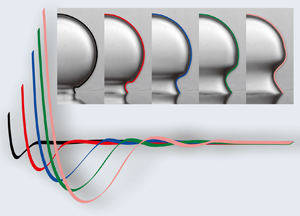Article contents
Dynamics of droplets under electrowetting effect with voltages exceeding the contact angle saturation threshold
Published online by Cambridge University Press: 24 August 2021
Abstract

Electrowetting on dielectric (EWOD) is a powerful tool in many droplet-manipulation applications with a notorious weakness caused by contact-angle saturation (CAS), a phenomenon limiting the equilibrium contact angle of an EWOD-actuated droplet at high applied voltage. In this paper, we study the spreading behaviours of droplets on EWOD substrates with the range of applied voltage exceeding the saturation limit. We experimentally find that at the initial stage of spreading, the driving force at the contact line still follows the Young–Lippmann law even if the applied voltage is higher than the CAS voltage. We then theoretically establish the relation between the initial contact-line velocity and the applied voltage using the force balance at the contact line. We also find that the amplitude of capillary waves on the droplet surface generated by the contact line's initial motion increases with the applied voltage. We provide a working framework utilising EWOD with voltages beyond CAS by characterising the capillary waves formed on the droplet surface and their self-similar behaviours. We finally propose a theoretical model of the wave profiles taking into account the viscous effects and verify this model experimentally. Our results provide avenues to utilise the EWOD effect with voltages beyond the CAS threshold, and have strong bearing on emerging applications such as digital microfluidic and ink-jet printing.
- Type
- JFM Papers
- Information
- Copyright
- © The Author(s), 2021. Published by Cambridge University Press
References
REFERENCES
- 11
- Cited by





